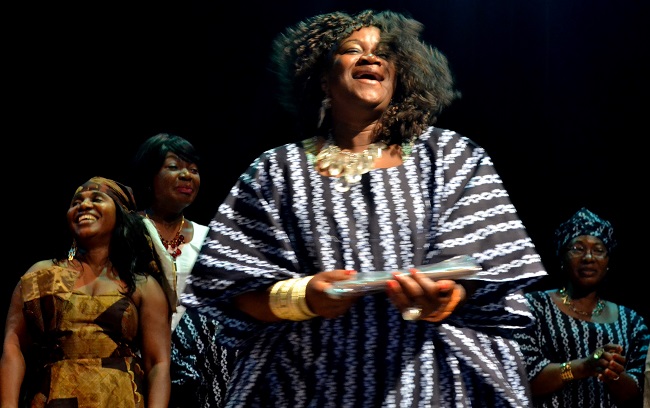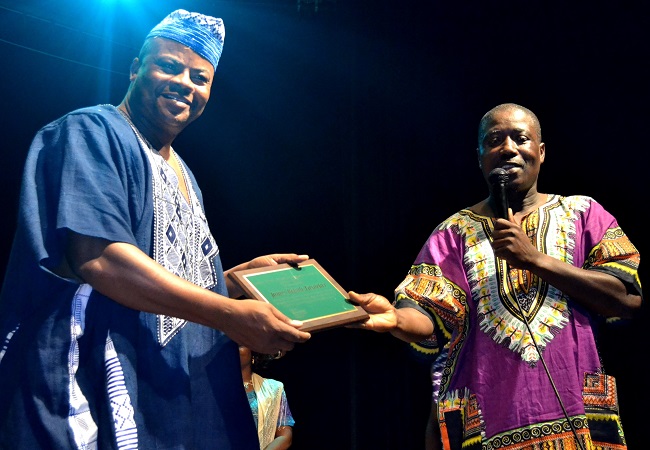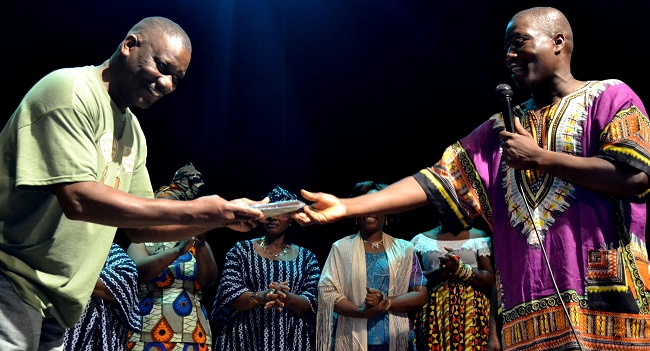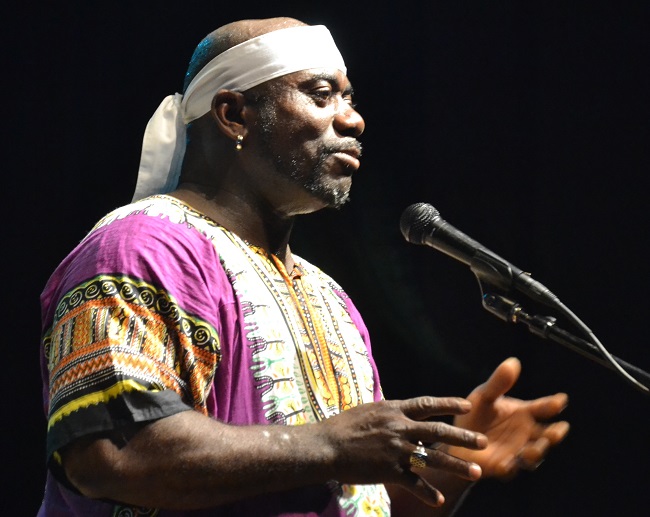In US, awards bring tears to Liberian artists

It is often said that a “Photograph speaks thousands of words.” This saying is certainly true as an elated Fatu Gayflor gets her award
Overwhelmed by excitement and not knowing how to react, scores of professional artists from the Liberian National Cultural Ambassadors (LNCA)Inc. of America, recently shed tears when their names were called out one after the other before a record crowd to be awarded; writes James Kokulo Fasuekoi.
The award ceremony was a surprise event set up by a few officials of the international ballet troupe for the honorees in recognition of their “invaluable services” to Liberian cultural heritage. The euphoria that characterized the award presentation which took place in Roseville, Minnesota, the US was indescribable.
Tears of joy
“Saturday was the happiest night for me,” remarked California resident Patrick Yeanay, a senior actor and dancer of the LNCA who flew in from California to participate in the group’s annual cultural festival held last August in Minnesota.
“In all the years we’ve been performing, no government has done what the group did for us,” said another artist, Nimely Napla. He was briefing LNCA’s president Mrs. Annie Zehyou, in a phone conversation during the group’s farewell meeting August 16th, Brooklyn Park, Minnesota. A family emergency had barred Zehyou from attending the festival.
Napla, artistic director for the group was spotted struggling to fight back tears as he received his award from Rev. Lusienie Fofana. Neither Napla nor Zehyou had been briefed about the award which took place during the show’s intermission. The idea came from Rev. Fofana and his wife Isabella Wreh-Fofana of St. Paul, Minnesota, both members.
First award in history
This award is historic and the first almost in the lives of all of the honorees, some of whom have traveled the globe and have been in the cultural show business for as long as 35 to 40 years.
In spite of this fact, they were never given recognition by the Liberian government or its cultural arms, the defunct National Cultural Bureau or the Cultural and Tourism branch of the Ministry of Information.
In all, about 18 senior artists, including national icons, received a plaque each as symbol for their sacrifices to promote and preserve Liberian culture. Among the honorees were the country’s known celebrated folksinger, Fatu Gayflor, of Philadelphia, and Annie Sirleaf, Minnesota, best known as “Garmai” for her role in Malawala-Balawala pre-war national television series.
Reason to celebrate
Honorees have plenty of reasons to be happy and celebrate because, some of Liberia’s nationally acclaimed cultural icons such as comedian Peter “Flomo” Ballah, comedian-choreographer Zumana Fofana (formerly of Guinea’s Ballet de’ African) and Liberia’s known oldest female performing artist, Gbessay Zinnah Kiazolu, all died without receiving honor from the state or any of its institutions.
What is so interesting about the three legendary artists is that they all served as great pillars for the former National Cultural Troupe and the Kendeja cultural center at certain point in time.
It is said that months prior to Kiazolu’s death, MICAT’s officials were still locked in intense argument as to whether or not she actually merited a state honor for her contributions to Liberian culture. And even in death, the state’s Cultural Affairs and Tourism Bureau has never honored her memory.
Fatu Gayflor, who was equally mystified by the honor and award, recalled that since coming to the US, after fleeing a brutal civil war, she had always felt “incomplete” till she got the recent award from the LNCA.
The one-time Kendeja star told this writer that though she has been fortunate to capture several big musical awards in the United States, like the “2012 Transformation Award” and the “2014 Pew Fellowship Award,” one of the highest in the state of Pennsylvania, she still never felt happy that her own country failed to acknowledge her hard work in the culture arena.

Author and artist Fasuekoi is excited as he receives award from the LNCA of the USA, the first in 33 years since he first joined the Liberian Cultural Ambassadors based in Liberia
“This action by my fellow artists made me too happy,” she told this writer shortly after the show.
Sacrifices
Whenever and wherever Liberia’s brutal 14-year civil war is mentioned, the roles of the various Liberian national comic and ballet dance groups have often been understated or not mentioned at all.
For example, while Fatu Gayflor lived in exile (in the Ivory Coast) and grieved over the loss of her youngest son, little three year-old Mohammed, who reportedly got missing in the Paynesville Redlight District of Monrovia, during the war, she still managed to shuttle between Liberia, Guinea and the Ivory Coast, always performing at Liberian refugee camps in those countries in order to bring some relief through music to traumatized Liberians affected by the war.
When former Liberia’s football legend George Weah organized a peace musical concert with the World Food Program in Milan, Italy, 1996 in order to raise funds for Liberian refugees everywhere as well as bring the world’s attention to the carnage that was taking place in the country, Fatu Gayflor volunteered and join other international artists to perform for free.
On the home front, many of LNCA’s members including most of those who received awards recently, found themselves touring belligerent rebel territories, including NPFL’s so-called “Greater Liberia,” where they hosted peace dramas aimed to encourage rebel fighters to end bloodshed and unify the country.
In the case of Liberia Cry for Peace, (which later traveled to the U.S.), the artists vigorously engaged fighters through anti-war dramas and by the end of the group’s tour to the various counties, some rebels, mainly child soldiers, surrendered their guns to the artists.
Most of the fighters who turned in their weapons often did so while the show went on. Some danced with the artists and even sobbed, expressing regret for their participation in the carnage before they surrendered their weapons.
Perhaps, the most memorable ones were a 12 year-old child soldier from ULIMO-K in Voinjama, Lofa, and a teen in Nimba who fought for Taylor’s rebel NPFL. After surrendering their AK-47 riffles to the artists, the head of Liberia Cry for Peace, Julie Endee brought the Nimba teen to Monrovia and placed him in her household with plans to have him go to school.
The surrendered guns were immediately turned over to the group’s small peacekeeping ECOMOG escort that accompanied the artists during their tour of Liberia.
Dangers during the tour
The journey by the artists done by land wasn’t a smooth one. For instance, in some faction’s territories, rebels openly scorned members of the cultural delegation and branded them as “agents” who allegedly belonged to rival factions on “reconnaissance mission.” Some would demand the artists to “go back” to Monrovia or else be arrested and jailed.
In Grand Cape Mount, a ULIMO-J rebel commander was found harassing a reporter travelling with the cultural group apparently on suspicion that the reporter belonged to then rival Mandingoe ethnic group who was in battle with breakaway Krahn dominated ULIMO-J faction of Roosevelt Johnson.
In another incident in the Zorzor District highway town of Konia (Lorma meaning, “war sweet”), then under the occupation of Alhaji Kromah’s ULIMO-K rebels, the peace crusaders’ convoy was delayed by fighters for nearly half hour around 1:am in the chilling dews as the group headed to Voinjama, capital of Lofa County.
A ULIMO commander at the Konia gate had contended that his faction’s hierarchy in the capital did not inform him of the troupe’s “mission” and as a result he demanded to have everyone disembarked the convoy so his fighters could conduct a “search and interrogation exercise.”
ECOMOG escort team threatens
This incident annoyed the head of the ECOMOG escort team who viewed the commander’s action as being an “insubordination” to his superior peacekeeping force. It resulted to a deep argument to the point that Kromah’s fighters threatened they would open fire on the convoy if it forces its way through as the peacekeeping commander had vowed.
The incident was however resolved and the convoy was allowed to move on. On board that convoy were about 35 to 40 artists, accompanied by three journalists, among them, this writer.
At the beginning of the tour Cry for Peace leader Endee had stated publicly that she wouldn’t seek permission or prior notice from any factions before going in due to the fact that those going were all Liberians.
Rebels not only danger
But dangers didn’t always come from rebels alone. In Nimba, one of the ECOMOG trucks carrying the artists nearly somersaulted into a big river. The incident occurred at dawn over a logged-bridge that partly collapsed.
Luckily, villagers nearby, came to the aid of the artists and peacekeepers and the truck was removed and the performers got back on the road to Monrovia.
Touched by the dance troupe’s perseverance the last ECOMOG peacekeeping force commander, Gen. Victor Malu, in his farewell speech to the nation, praised the artists for their “bravery and determination” to serve their country and people especially during such critical period.
photo credit: Mozart Dennis/YES



